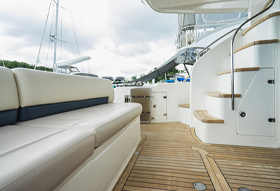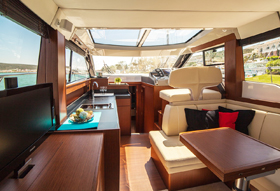
Foam for Boats | Marine Foam | Boat Cushion Foam

The diverse uses of foam mean that it also plays a significant role in non-land-based uses. Boats of a variety of shapes, sizes and ages – from yachts to long boats, to motor cruisers, sailing boats and cruise ships – incorporate many different types of foam depending on the intended application.
The most common application for foam in boats (marine foam) is to ensure comfort for passengers. This includes using foam in boat beds / mattresses, boat seating and boat chairs. However, foam also brings benefits in its form as a large cavity filler. Hulls are commonly filled with polyethylene foam to ensure insulation and buoyancy – the latter being a basic requirement in order to fulfil stringent safety and quality standards. Closed-cell foam (i.e. polyethylene foam) for boats is an element lighter than water, and when present in the hull it offers a high degree of adhesion to the inner surfaces. This in turn ensures optimum buoyancy.
Foam is also widely used in a whole range of boats for insulation purposes. Heat insulation is particularly important on boats that are frequently occupied for a period of time, such as cruise ships, long boats and sailing boats. Many boat owners are keen on using spray foam, however, closed-cell polyethylene sheets are the only type of foam that help to ensure equal levels of insulation throughout a vessel. As a very strong and chemically resilient foam, it is resistant to chemicals, grease, mildew, rot and bacteria, and is also lightweight and flexible – perfect for a boat. Alternatively, those who own houseboats often look for a foam with sound insulation properties. For this reason, Pyrosorb-S Class 0 acoustic foam sheets are also built into a boat’s infrastructure by some owners.

Reticulated polyether foam is considered by many as the most popular type of boat foam. Its mesh-like structure makes it an appropriate foam for boat seating as it can sieve water. It varies from regular polyurethane foam by removing the cell faces, leaving a more open structure that allows for water escape. In turn, reticulated foam tends to have a far longer lifespan than conventional polyurethane when used on boats because it is able to stay considerably drier throughout its life. Wet foam commonly breaks down at a much faster rate, and although some polyurethanes are impervious to mildew and mould, many still break down quicker than reticulated foam. Reticulated polyether is therefore considered a worthwhile investment for a range of boats where seating may be exposed, such as speed boats, yachts and sailing vessels.

Lastly, foam is of course used to achieve indoor comfort. Used in a range of built-in sofa and chair compartments on boats, high density polyurethane foam is a popular choice for both its comfort and durability. Alternatively, some boat owners tend to opt for Reflex foam for its unparalleled comfort, durability and instant recovery properties. At eFoam, we are able to supply foam cut to size, thickness and shape, meaning that your choice of foam material and the shape to which it’s cut is truly down to personal preference.
eFoam is the leading supplier of foam for the marine industry and we pride ourselves on our expertise and knowledge. Should you require any assistance regarding foam for your boat, please contact us.


